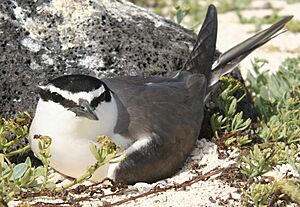Spectacled tern facts for kids
Quick facts for kids Spectacled tern |
|
|---|---|
 |
|
| Conservation status | |
| Scientific classification | |
| Genus: |
Onychoprion
|
| Species: |
lunatus
|
| Synonyms | |
|
Onychoprion lunata (lapsus) |
|
The spectacled tern (Onychoprion lunatus), also called the grey-backed tern, is a type of seabird. It belongs to the family called Laridae, which includes gulls and other terns.
Contents
What Does It Look Like?
The spectacled tern is a close relative of the Bridled tern and sooty tern. People sometimes confuse these birds. This tern is not as common as its relatives. Scientists have also studied it less.
These three species, plus the Aleutian tern, were recently grouped into a new genus called Onychoprion. Before, they were part of the Sterna genus.
The spectacled tern looks a lot like the sooty tern. But it has a grey back instead of a black one. Its chest and belly are white. It also has a black line that goes from its beak to the back of its head, right through its eye. This line makes it look like it's wearing "spectacles"!
Where Do Spectacled Terns Live?
The spectacled tern makes its nests on islands in the warm tropical areas of the Pacific Ocean.
Breeding Areas
In the northern part of its home range, it nests in the Northwestern Hawaiian Islands. The biggest group of these birds lives on Lisianski Island. They also nest on two small islets near Oahu.
Further east, you can find their colonies in the Tuamotu Islands. Other nesting spots include the Society Islands, the Line Islands, Phoenix Islands, Mariana Islands, and American Samoa. There are also some reports of them breeding as far south as Fiji and as far east as Easter Island. However, these reports are not fully confirmed.
Scientists don't know much about the groups of spectacled terns outside of Hawaii.
Migration and Travel
When it's not breeding season, these birds are partly migratory. This means they travel to different places. Birds from the Hawaiian Islands fly south for the non-breeding season.
Scientists think that spectacled terns from other parts of the Pacific also migrate. They might spread out to places like Papua New Guinea, the Philippines, and Easter Island.


